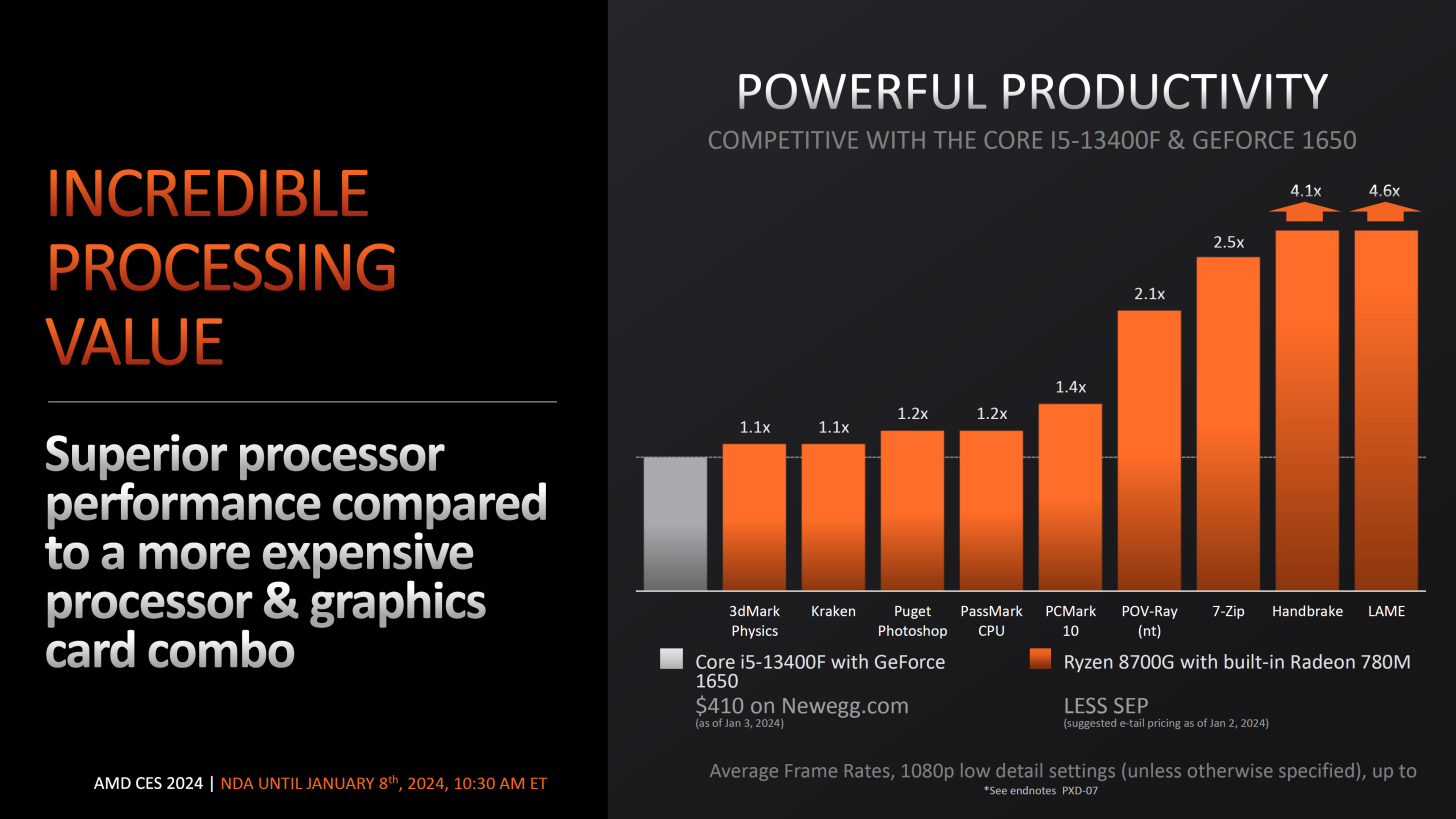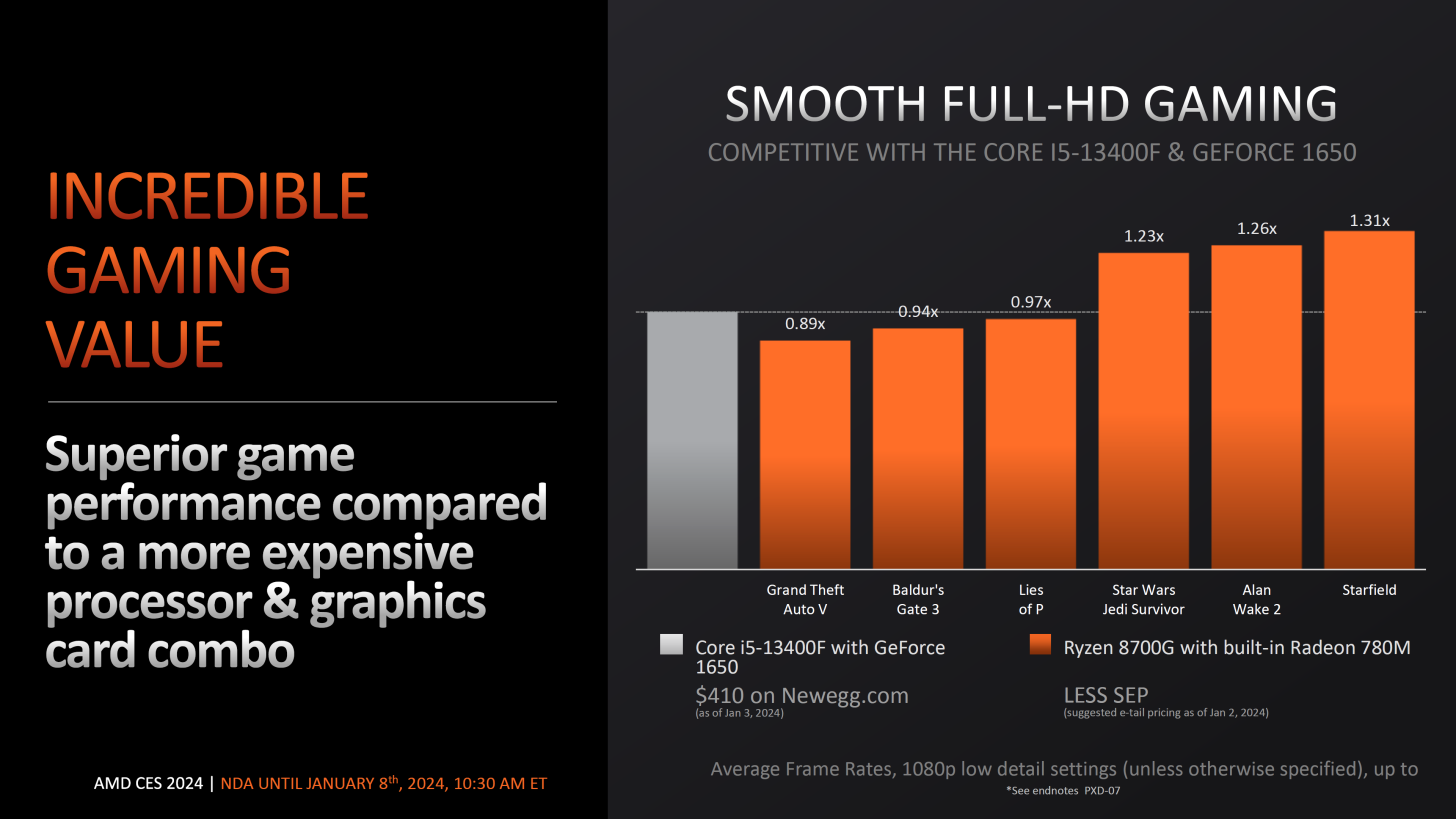AMD Unveils Ryzen 8000G APUs for AM5 at CES 2024: Up to 1.31x Faster Than a Desktop GTX 1650
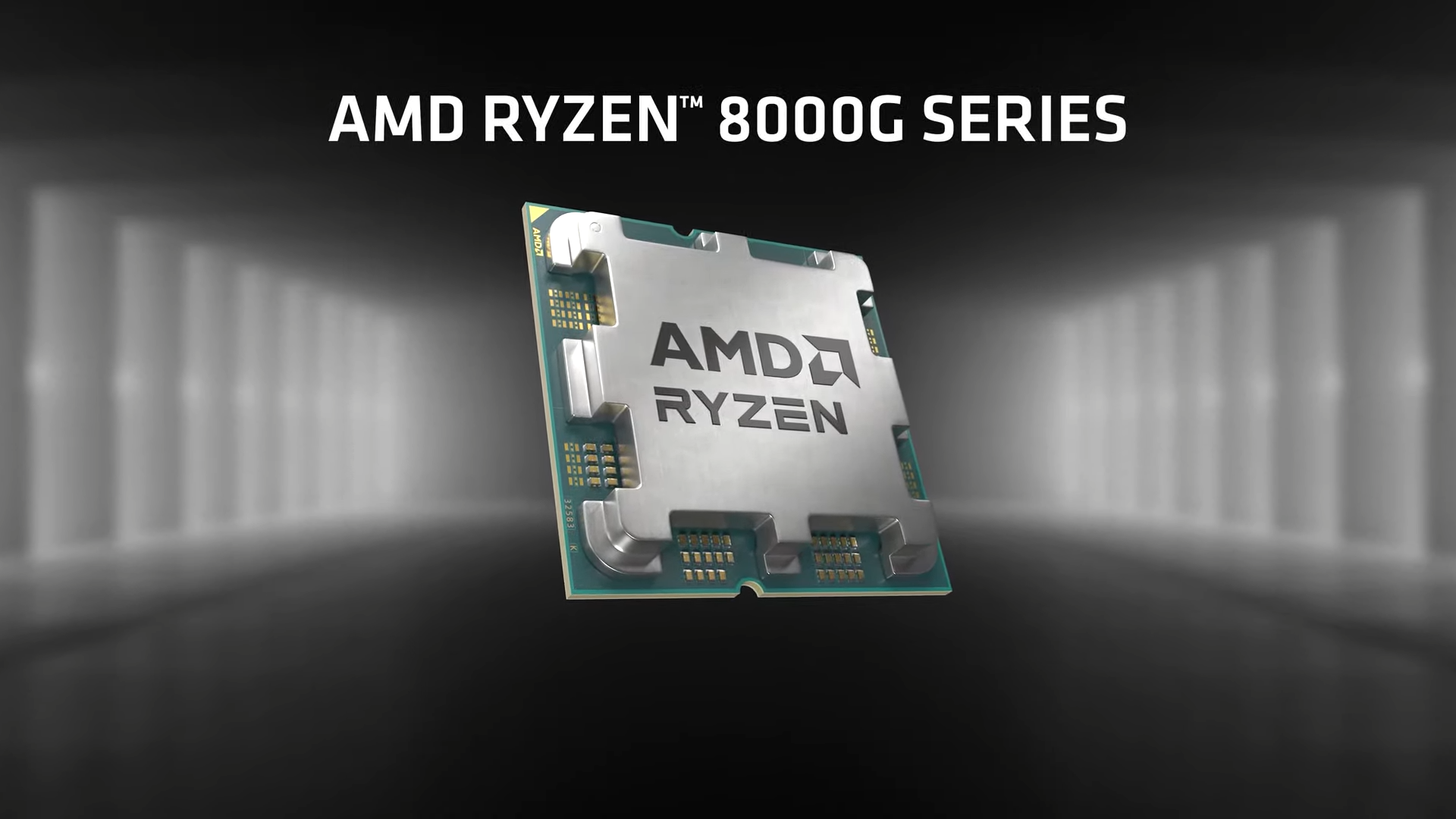
Kicking off the CES season, AMD has formally launched its APU offerings for the current AM5 platform. Under the Ryzen 8000G branding, Team Red plans to integrate Zen4 and RDNA3 in a single package. These new APUs offer massive performance improvements over Cezanne and make many discrete low-end GPUs almost obsolete.
Ryzen 8000G: Fusion of Zen4 and RDNA3 Ready for Desktop
Based on Phoenix 1 and 2, the Ryzen 8000G lineup is the successor to Ryzen 5000G or Cezanne. We have already seen a glimpse of these APUs in the mobile segment, particularly on laptops and handhelds. More specifically, the ASUS Rog Ally is a noteworthy mention, powered by AMD’s Z1 series, a derivative of Phoenix.
These APUs arrive in both Phoenix 1 and Phoenix 2 flavors, though only the Ryzen 7 8700G and the Ryzen 5 8600G are based on the former. All Ryzen 8000G series APUs feature a base TDP of 45W/65W, with the Ryzen 8000GE series limited to 35W. As self-explanatory as it may be, these APUs are supported by AMD’s latest AM5 platform.
- CPU Based on Zen4
- iGPU Based on RDNA3
- Up to 8 Zen4 Cores / 16 Threads
- Up to 12 Compute Units (6 WGPs)
- TDP of 45W/65W (G Series) | 35W for GE Series
- Up to 5.1GHz Boost Clocks
- Support for PCIe Gen 5.0
- Inclusion of Ryzen AI on Phoenix 1 APUs
We’re not just witnessing a CPU architectural upgrade from Zen3 to Zen4, rather the iGPU is also seeing a huge leap from Vega to RDNA3. Prior generations of RDNA were skipped on desktop (As iGPUs) due to a lack of sufficient memory bandwidth. With the inception of fast DDR5 memory, that no longer remains a constraint.
Ryzen 8000G Specifications
Let’s quickly go over the specifications, then we’ll talk about performance. The flagship Ryzen 7 8700G packs 8 cores / 16 threads with base and boost clocks of 4.2GHz and 5.1GHz. It hosts the Radeon 780M iGPU with a maxed-out 12 CU configuration, clocked at 2.9GHz. The Ryzen 7 8700G will come in at $329.
From the Ryzen 5 family, the Ryzen 5 8600G offers 6 cores / 12 threads operating at 4.35GHz and 5GHz (Base/Boost). The iGPU is stepped down to the Radeon 760M with 8 CUs at 2.8GHz, still adequate for most if not all eSports titles and even a few AAA games. Priced at $229, the Ryzen 5 8600G will hit shelves later this month.
Both the Ryzen 7 8700G and Ryzen 5 8600G include Ryzen AI since they are based on a Phoenix 1 die.
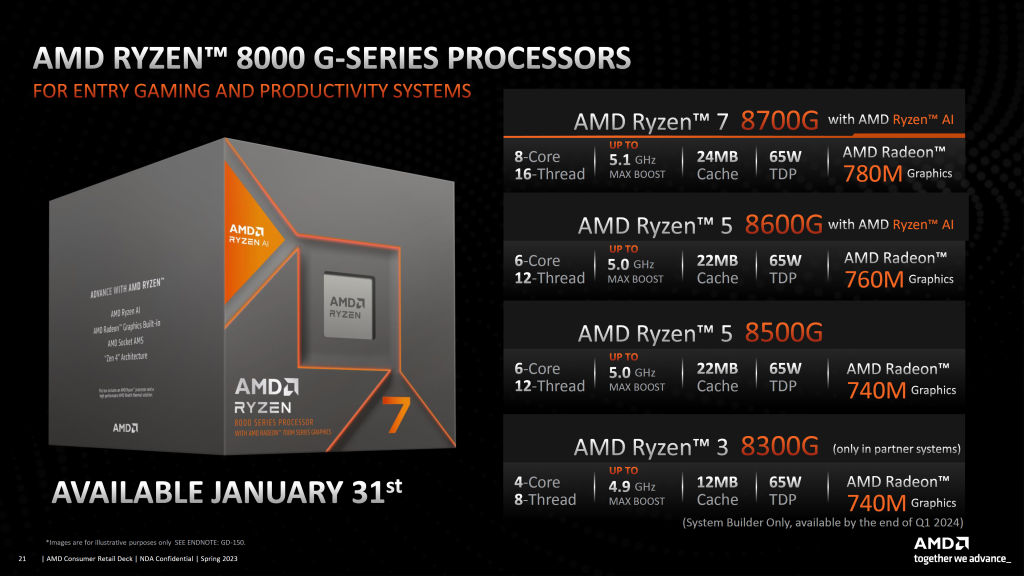
Now come APUs based on Phoenix 2, which are a hybrid of Zen4 and Zen4C cores. The Ryzen 5 8500G has 6 cores (2 Zen4 + 4 Zen4C) / 12 threads running at 3.55GHz and 5GHz respectively. A 4 CU version of the Radeon 740M is present as the graphics solution. The Ryzen 5 8500G has been listed with a price tag of $179.
The Ryzen 3 8300G follows with 4 cores (1 Zen4 + 3 Zen4C) / 8 threads clocked at 3.45GHz (Base) and 4.9GHz (Boost). Much like the Ryzen 5 8500G, AMD has opted for the Radeon 740M (4 CUs) for this APU as well. This processor can be found in OEM-only PCs and will be available by the end of Q1 24.
The Ryzen 5 8500G and Ryzen 3 8300G do not feature Ryzen AI.
Performance
In the first set of tests, AMD striked a comparison between Intel’s i7-14700K and the Ryzen 7 8700G/8600G. The i7-14700K features UHD Graphics 770 with 32 EUs, based on the Xe-LP architecture, the forerunner to Xe-LPG seen on Meteor Lake.
When normalized to the i7-14700K, the Ryzen 7 8700G pushes performance as high as 4x the Intel CPU in Hitman 3. Apart from the extremes, there is a huge average performance gap, with most of the chart ranging from 2-3x, Far Cry 6 being the exception.
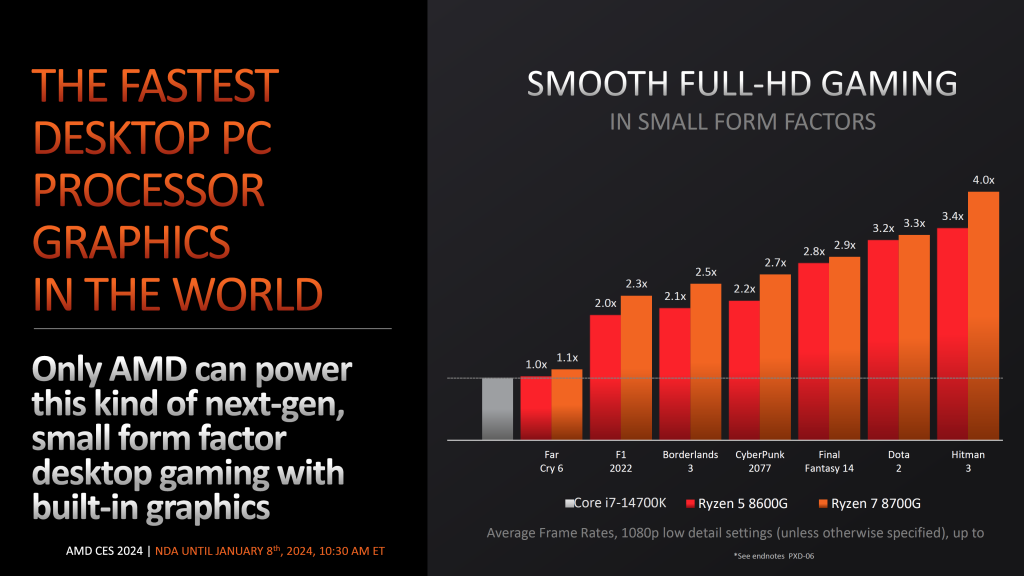
The next benchmark features a $410 mid-range PC from Newegg with the i5-13400F and NVIDIA’s GTX 1650 4GB. This is a modest PC, yet the Ryzen 7 8700G demolishes it, again justifying our point of making entry-level dGPUs obsolete.
A few games such as GTA V, Baldur’s Gate 3, and Lies of P see the Newegg system pull ahead. However, that lead diminishes it titles such as Star Wars Jedi: Survivors, Alan Wake 2, and Starfield where the AMD system is up to 1.31x faster than the GTX 1650/i5-13400 combo.
Productivity is where AMD has a remarkable lead, not faltering in any of the shown tests. In softwares such as Handbrake and LAME, Ryzen 8000G smokes its counterpart by up to 4.6x. A similar, though slightly small lead can be seen in other tests as well.
Conclusion
Let’s be realistic, given what AMD has shown, new mid-rangers such as the one showcased above should be superseded by APUs like the Ryzen 8000G. While sounding a bit gloomy, this significant leap in APU performance should and will drive GPU manufacturers to put more effort in sub-75W offerings.
The Ryzen 8000G lineup will launch on the 31st of January, alongside other AM4 CPUs. Moreover, since these are APUs, they heavily rely on fast, low-latency DDR5 kits. Be sure to get an appropriate memory kit if you plan on purchasing these APUs.
| Model | Cores/Threads | Boost / Base Frequency | Total Cache | TDP | NPU | SEP | |
| AMD Ryzen™ 7 8700G | 8C/16T | Up to 5.1GHz / 4.2GHz | 24MB | 65W | Yes | $329 | |
| AMD Ryzen™ 5 8600G | 6C/12T | Up to 5.0GHz / 4.3GHz | 22MB | 65W | Yes | $229 | |
| AMD Ryzen™ 5 8500G | 6C/12T | Up to 5.0GHz / 3.5GHz | 22MB | 65W | N/A | $179 | |
| AMD Ryzen™ 3 8300G | 4C/8T | Up to 4.9GHz / 3.4GHz | 12MB | 65W | N/A | N/A | |
